Dirty Romans!
| Prestatyn Roman bath house | 53 19 27.73N 03 24 34.43W | The baths can be clearly seen sandwiched between modern housing. The fort it served was higher up the slope where the school playing fields are now. |
| Castellum Aquae | 40 45 11.54N 14 29 02.95E | The small square building just inside the Vesuvian Gate is the water tower for Pompeii. |
| Baths of Caracalla | 41 52 45.34N 12 29 35.29E | The picture of this huge building is particularly good. I wish everything on Google Earth was this clear! |
| Philippi toilets | 41 00 42.76N 24 16 26.32E | The toilets are just south-west of the ruined Basilica B. |
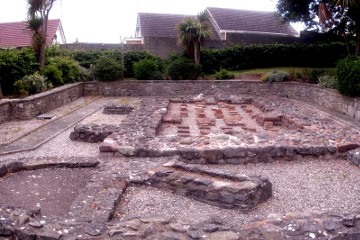
| |
| There is not much left of the Roman bath house in Prestatyn. |
Half a mile down the road from where I live is the remains of a Roman bath house. When we recently went on holiday to the north of Scotland, our first stop on the long trek north took us past a Roman bath house associated with the Antonine Wall. When I took the Diggings tour group to Olympia in Greece, we were amused to notice that the big, circular, outdoor cold bath which the Greek athletes used after their exertions, was replaced in Roman times by a heated bath with all the usual Roman trimmings.
Roman baths spread wherever the Roman empire extended its sway, from the banks of the Euphrates to the shores of the Channel, from the dreary forests of Germany to the even drearier desertes of Egypt and north Africa. The result, surprisingly, is that the Roman were the dirtiest race that has ever walked our planet.
Dirtiest, that is, on the inside - though I venture to suggest that the outside wasn't exactly a bed of roses either.
To understand why, let's go on an imaginary visit to a typical Roman bath house. You and a friend - or, it might be, business partner or prospective customer, for bath houses were as much about meeting people and conducting business in a pleasant environment (a bit like a modern day golf course) - would stroll down the street to the local bath house. In some you might have to pay to enter, but most were provided by the state or the local civic authorities as part of the cultural ammenities of the town.
In the entrance you would be greeted by a slave at the check-in desk who would take your clothes and place them in the sort of pigeon holes used by swimming pools and cloakroom attendants. Exactly how they knew whose clothes were whose is not known, but I can be certain they didn't issue you with rubber bands to put on your wrists, as rubber had not yet been invented.
From the atrium or entrance foyer you passed into a room dominated by a pool of cold water and it is at this point that we need to stop and consider that water. Water for Roman cities was usually transported over a considerable distance by means of an aqueduct, a marvel of civil engineering in which the water might drop as little as a foot over several miles. Where necessary the aqueduct consisted of a channel carried on a long line of masonry arches, but in other places aqueducts might pass through tunnels or consist of nothing more than a stone-lined ditch running across a field.
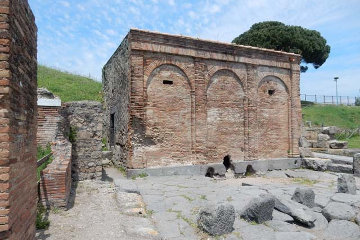
| |
| The so-called "Castellum Aquae" in Pompeii, really the water tower from which water was distributed to the whole city. |
To take just one example, Pompeii was served by an aqueduct 60 miles long which started at Serino in the mountains to the north-east of the city and supplied water to eight towns around the bay of Naples. The branch which served Pompeii emptied into the Castellum Aquae from where it was distributed to fountains and a few lucky villas around the city. The Castellum Aquae received 42 litres per second (a bit less than 10 gallons) which may sound like a lot, but when divided among 12,000 people living in Pompeii at the time of its destruction isn't really all that much.
If you do the maths, it comes out at 302 litres per person per day, but of course that had to shared with all the animals and gardens in and around the city. And, of course, with the baths.
The result was that your average bath was filled as soon as the plaster was dry and topped up when necessary, but other than that, it remained the same day after day and year after year. In the heat of an Italian summer it wasn't long before the water, enriched by everything that washed off the bathers, soon grew a rich crop of something nasty and turned a turgid green or even brown.
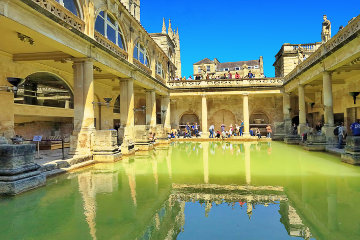
| |
| The Roman baths in Bath were fed by a thermal spring, which ensured plenty of fresh, hot water. |
If that was true of the cold pool, it was much more the case with the warm and hot pools. Heating water takes a lot of fuel and you are not going to throw away all that precious heat just because the water is no longer sparklingly clear. Places like Bath, in England, where the Roman baths were fed by natural hot springs, were few and far between.
We, on our putative visit to the baths, leap or climb into the cold pool - depending on our temperaments and whether our visit was in summer or winter - and splash around a bit before heading for the great comfort of the warm pool, where is probably where the serious business discussions took place. It was also where the heterae were to be found, the good-time girls who made visits to the baths more enjoyable.
Finally we move into the hot room. In the enormous Baths of Caracalla in Rome, this might be a large a spacious room - though even there it was covered and enclosed to keep the heat in - but in most baths it was small and cramped. The hot pool, from which steam was gently rising, was surrounded by stone steps on which men sat while they sweated - rather like a Finnish sauna. From time to time you might lower yourself into the hot water but you didn't stay long. A few minutes at most and you emerged as red as a lobster to sit on the steps and sweat some more.
The one thing you did not do was lean back against the walls. Not only was the furnace more or less directly beneath your feet, but the floor consisted of thick tiles mounted on short pillars and the walls were made of hollow bricks. The heat from the furnace not only warmed the floor but also rose up through the walls. In mid-winter up by Hadrian's Wall, while the sleet pelted the walls of the bath house and melted up the hot room end, you might find comfort in hugging the walls. In most other parts of the world, however, the walls varied from uncomfortably warm to unbearably hot.
We - and the men around us, are clutching a piece of curved metal called a strigil. Once the heat and sweat has loosened the dirt on our oiled bodies, we scrape the strigil over our skins to remove the dirty oil. It was a fairly brutal procedure and more than one ancient writer noted that some men had roughened skin as a result of over-zealous application of the strigil.
You could, of course, simply flick the mess off your strigil onto the floor or wall, but civilised men - as opposed to barbarians - would run their finger down the length of the strigil and wipe the gunk off and allow it to fall into a large clay pithos placed there for the purpose by the management of the baths. They made a small but not-to-be-despised income from selling the oil on to the lower classes to be used for lighting - so if your oil lamp smells funny, it might be worth asking your domestic slaves where they got the oil with which it is filled!
Finally we emerge from the hot room and run out to the cold room where we leap into the cold water to "close the pores" and set our pulses racing. Once our bodies have recovered from the shock we climb out more decorously and return to the atrium where the slave is waiting - or it may be our personal slave - with a bottle of oil. Nice and fresh from the baths, we decant a little of the oil into our hands and smooth it over our skin so that we can emerge from the baths sleek and shiny and smelling like gentlemen, as Plato put it!
Meanwhile, back in the hot room, we need to consider that water a bit more.
Aulus Cornelius Celsus, who lived from 25 BC to AD 50, wrote a book called "On Medicine" (
Among his observations he notes that those who go to the baths with an open wound are likely to suffer gangrene in the wound. He roundly declares that bathing is "one of the worst things to do"!
Also there should be a definite rule as to position for a limb which has been wounded. If the wound is seem to be agglutinated, the limb is kept raised; it must not be bent either way if there is still inflammation; if pus is already being discharged it should be hanging down. The best medicament too is rest; movement and walking before healing are adverse. The danger, however, from movement is less for wounds of the head and arms than for the lower limbs. Walking about is least of all suited to an injured thigh or leg or foot. The patient's room should be kept warm. Bathing, too, while the wound is not yet clean, is one of the worst things to do; for this makes the wound both wet and dirty, and then there is a tendency for gangrene to occur.
Celsus wasn't the only one to be concerned over the mixing of healthy and sick people in the baths. The Emperor Hadrian is supposed to have ordered that the sick should not bath at the same time as the healthy; they should go to the baths first and only when they were out of the way were the healthy admitted!
Back in the heroic days of archaeology the archaeologist sat in his tent and sketched in his notebook while a hundred or more natives flailed away with shovels, hoes and pickaxes. He only emerged if something significant was found, like a stone statue or a hoard of gold.
In a more scientific age archaeologists and their assistants carefully cleared away the dirt with trowels and brushes, thereby preserving bones, potsherds, and small beads. Then came the discovery that dirt might contain pollen, which provided invaluable evidence about the crops that were growing, the time of year when the layer of dirt or ash was laid down, even the climate at the time.
Now, however, we are coming to realise that the dirt so carefully brushed off the bones might be even more valuable than the bones themselves. Dirt in the pelvic area is likely to contain the eggs of parasites and even the proteins that act as fingerprints for amoebae such as dysentery.
It is from a study of this evidence that Piers Mitchell, a palaeopathologist from Cambridge University, has been able to trace the spread of disease in the Roman world. In every location he studied he discovered that before the Romans arrived the dominant internal parasites were roundworm, whipworm and the amoeba that causes dysentery. The situation remained much the same after the Romans introduced their baths in the conquered territories, along with tapeworms, flukes and nematode worms, all of which are linked to faeces.
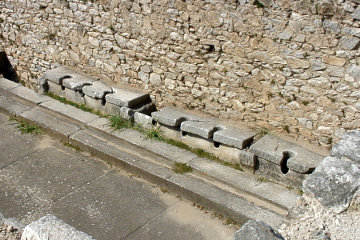
| |
| The public toilets in Philippi, Greece. |
Which brings me neatly to Roman toilets. There are some quite splendid examples in Ephesus and Philippi and I have only to mention "Roman toilet" and tour group members who were starting to flag at pyramids and temples suddenly perk up. We enter the building and there is a general dash to be seated on the "throne" while wife or girl-friend takes a photograph.
These public toilets consist of a large room, with stone toilet seats arranged around the walls in long rows - going to the toilet was a group activity in Roman times, with no concessions to modesty. Once the tour members have been photographed most of them stand up and peer down the hole on which they have been sitting. Some four feet below there is a deep channel which was flushed by running water that - in intention, at least - carried off whatever was dropped in it.
Sometimes, of course, the flow of water was not sufficient to flush the row of toilets and then noxious gasses could build up. According to Ann Olga Koloski-Ostrow, author of a book about Roman toilets, the gasses could spontaneously explode, sending flames shooting up through the toilet seats and, no doubt, sending the users of those toilet seats shooting out through the door in a state of culus combustibus.
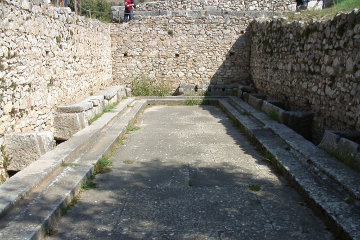
| |
| The water channel in the Philippi toilets, used for personal cleansing. |
Many of my groups then notice that at their feet and running round in front of the rows of toilet seats there is a much smaller channel, perhaps 4" wide and an inch deep. That, I tell them, was the toilet paper.
As you enter the toilet the slave at the entrance handed you a two-foot long stick, to one end of which was fastened a sponge. When you had completed your business, you reached down with the stick and dabbled the sponge in the water flowing in that little channel, then used the moist sponge to clean yourself. You repeated this as often as necessary and then, on the way out, you handed the stick back to the slave, ready to be reissued to the next customer.
The results, with regard to disease and intestinal parasites, speak for themselves. Professor Mitchell reports that whipworm, spread by contact with infected faeces, was the most common parasite in the Roman empire.
Surprisingly, larger parasites such as lice and fleas also showed no decrease from all that bathing. Dr Mitchell's conclusion is that although the Romans bathed themselves, they were less scrupulous about their clothing and no matter how carefully you wash yourself, if you then don garments rich in fleas it isn't long before you are scratching as vigorously as before!
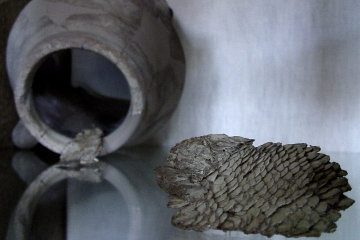
| |
| A pot containing garum found in a merchant's house in Corinth. |
Diet also played a part. The Romans were fond of a condiment called garum, a sauce made of rotted fish and herbs. It sounds revolting. In the Corinth museum there is a bit of dried fish skin, complete with scales, that came from Atlantic bream and tuna. Obviously that jar of garum was not rotted well enough! However the Romans did not limit their taste to Atlantic fish, but eagerly sought garum from exotic locations such as the Baltic and the great rivers Rhine, Rhone, Loire and Seine. In the waters of France and Germany fish suffered from the fish tapeworm, whose eggs are destroyed by cooking but are entirely unaffected by fermentation.
Packed in sealed jars, garum was traded around the Roman empire with the result that the fish tapeworm soon become common in places as far apart as Poland, Britain and Israel!
Such culinary delights aside, private toilets and even many public ones were not flushed but were nothing more than cesspits. These required regular emptying and the slaves who had the unpleasant job - or, more likley, their owners - sought to put into effect that Yorkshire maxim, "Where's there's muck there's brass". The contents of the cesspits were sold to farmers, who put it on their market gardens as fertiliser.
While any such contamination could be removed by washing or neutralised by cooking, you would only have to eat a raw carrot and you would have infected yourself all over again with whipworm, round worm and all the rest of the unlovely companions to daily life.
All of which gives point to the stipulations in the Didache, an early Christian document otherwise known as The Teaching of the Twelve.
But concerning baptism, thus shall ye baptise. Having first recited all these things, baptise {in the name of the Father and of the Son and of the Holy Spirit} in living (running) water. But if thou hast not living water, then baptise in other water; and if thou art not able in cold, then in warm.
But if thou hast neither, then pour water on the head thrice in the name of the Father and of the Son nd of the Holy Spirit. But before the baptism let him that baptiseth and him that is baptised fast, and any others also who are able; and thou shalt order him that is baptised to fast a day or two before.
It is obvious that the early church did not baptise infants, who would certainly not be able to fast for a day or two before the ceremony! It is also clear that baptism, as the word implies, was by immersion, for pouring - standard practice in many churches these days - was only a concession if more abundant water was not available.
Baptism is supposed to be a symbol of cleansing, which is why using warm water - the local Roman baths - for the cermony was very much second best. The ideal was a stream of running water, but if you lived in some place where the only water supply was a Roman aqueduct, then you might be forced to use a Roman bath. For preference you should use the cold pool, where the bathers were least likely to linger and the water was less filthy than the other pools. Only if, for some reason, that was not available were you to use the warm pool in the baths.
Whether baptism cleanses you of your sins is a matter for theologians to debate, but at least with Christian baptism, you were less likely to come away contaminated by the filth, fecal matter and fleas floating in the Roman baths.
© Kendall K. Down 2016





